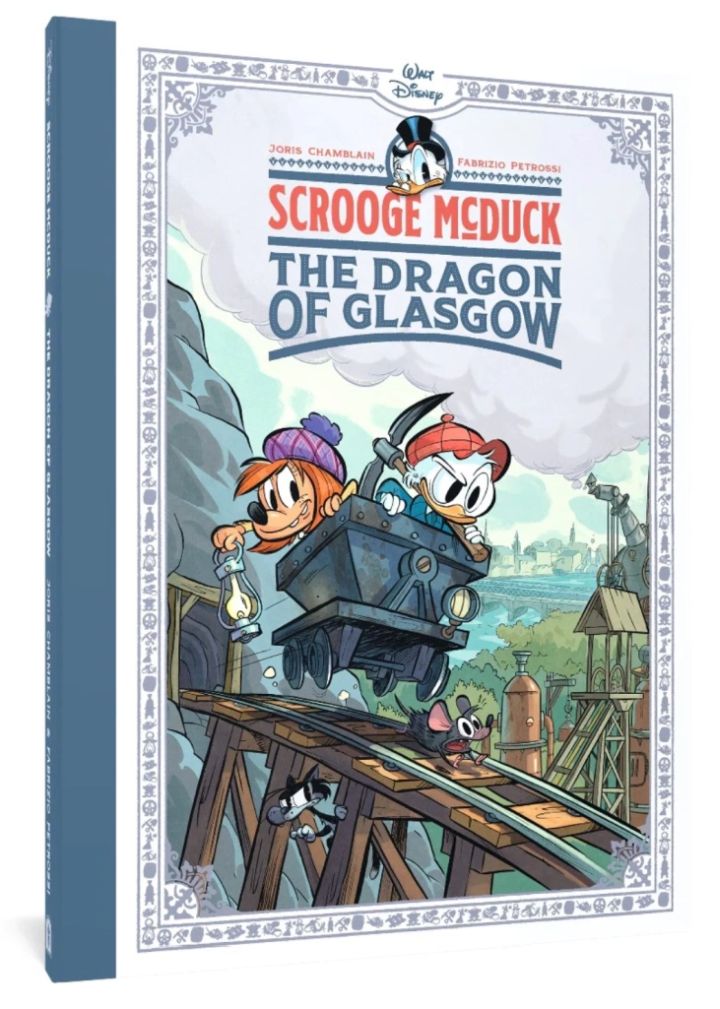
Scrooge McDuck is best known from either DuckTales, or from the 1983 Disney Short, “Mickey’s Christmas Carol.” There he played, of course, Ebeneezer Scrooge. Disney fans might not know that Scrooge came from comic books. Originally a minor character in Donald Duck comics (“Let’s give Donald a rich uncle to annoy”) introduced in 1947, he became a complex and interesting character of his own with a rich, developing history.
Carl Barks, the best of the early Duck comic authors, created Scrooge McDuck. He also created increasingly varied and complex adventures for him to go on, creating a patchwork history of his storied life. In the ’90s, artist and writer Don Rosa undertook a project to weave the varied stories into a complete history, which became The Life and Times of Scrooge McDuck. This 12-comic series details Scrooge’s life from his early days as a shoe-shine boy in Glasgow in 1877 to just when he was being introduced to the world, in 1947. It’s a sprawling work.
It also leaves a lot of room for side stories and expansion, which is where this slim, beautifully produced book comes in. Scrooge McDuck: The Dragon of Glasgow is an additional story about Scrooge’s youth, from just before he lit the fire in himself to become the patriarch of the McDuck fortune.
Here, Scrooge is a scrappy youth in a poor neighborhood in Glasgow where the only future anyone has is the local iron mine. Scrooge and his pals are too young to understand how poor they are, or how dangerous playing in the mines can be. Exploring abandoned shafts is their main source of entertainment. That changes when Scrooge accompanies a local inventor to deliver some devices to a theater uptown that needs some special effects. There, he falls in love with the showmanship… and develops a crush on a young actress, Erin.
They become friends and visit each other though Scrooge knows his father doesn’t want him going to the rich part of town. The McDucks used to have a vast fortune, and still own lands and a castle in Dismal Downs. But they were chased out by ill-fortune, and the lands have been occupied by the Whiskerville clan ever since. It can be dangerous for a poor duck to go where he isn’t wanted.
But Scrooge has caught the acting bug, and maybe a bit of a love bug. He gets a chance to show it when the theater performs Romeo & Juliet at the iron mine. Scrooge and Erin play the titular parts. Unfortunately, a rival of Scrooge’s chooses that time to announce that Erin is not, as Scrooge believed, the niece of the theater owner. She is in fact a Whiskerville, a member of McDuck’s greatest rival. That family rivalry laid bare pulls Scrooge and Erin apart.
The Dragon of Glasgow is an example of a form of European comics called Bandes Dessinees. Typically for a French or Belgian audience, the Bandes Dessinees are like graphic novels, but typically shorter. This book, for instance, is only 56 pages long. That’s about the length of 2.5 American comics. But it tells a single, complete story, with detailed, sometimes painterly artwork and storytelling perfectly paced for its length.
The art is by Italian Disney Comics artist Fabrizio Petrossi. His characters are rounded and a little squat (the publisher Fantagraphics describes it as an “animation-inspired style”) but his backgrounds are expressive. He uses cinematic lighting and layers of detail to create a rich visual experience. In this book, he likes to populate his frames with animal witnesses, as well. Several scenes have a cat and mouse pair watching on, or a seagull with always a different fish in its mouth. It’s a cute touch that adds life to the scenery.
The story, by French author Joris Chamblain, deftly weaves the narrative around already established Scrooge McDuck lore. Several events in this story take place in between the events of the first issue of Don Rosa’s The Life and Times of Scrooge McDuck. He also creates a kind of social realism to Scrooge’s early life. It fills in details of his life and prospects in a Glasgow slum that the future Richest Duck in the World would rapidly outgrow.
The story is beautifully told. It does the neat trick of creating obvious villains and conflicts, and then by expanding on them making them more complex and nuanced. Even the obvious heavy, the iron mine owner, is given a chance to show humanity and concern for his workers.
Cleverly, the entire story is told in a framing narrative, where old Uncle Scrooge’s grand-nephews, Huey, Dewey and Louie are prodding the old man about his past, which he won’t talk about. It’s only from a letter from one of Scrooge’s sisters that they find out the truth. So, the prime Ducktales characters are involved, even if the narrative is about Scrooge’s distant past.
Scrooge McDuck: The Dragon of Glasgow has been published by Fantagraphics in a beautiful hardcover edition. The story was originally published last year in French. It’s a fun addition to Scrooge lore, and a fine story about growing up, as well. In just 56 pages, it tells a complete story about love, family pride, and (always befitting an Uncle Scrooge story) commercial ingenuity. Scrooge McDuck: The Dragon of Glasgow goes on sale today from Fantagraphics.